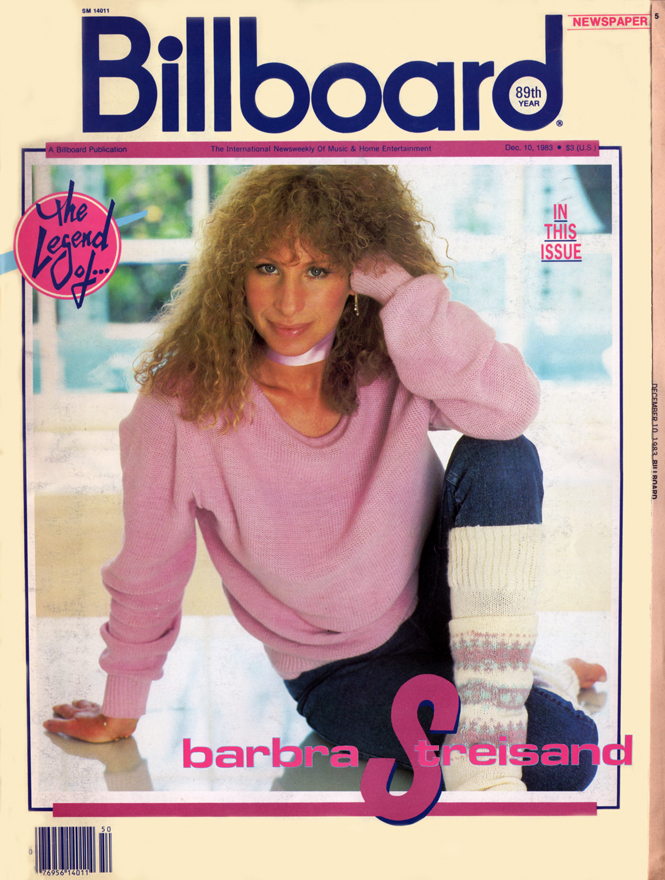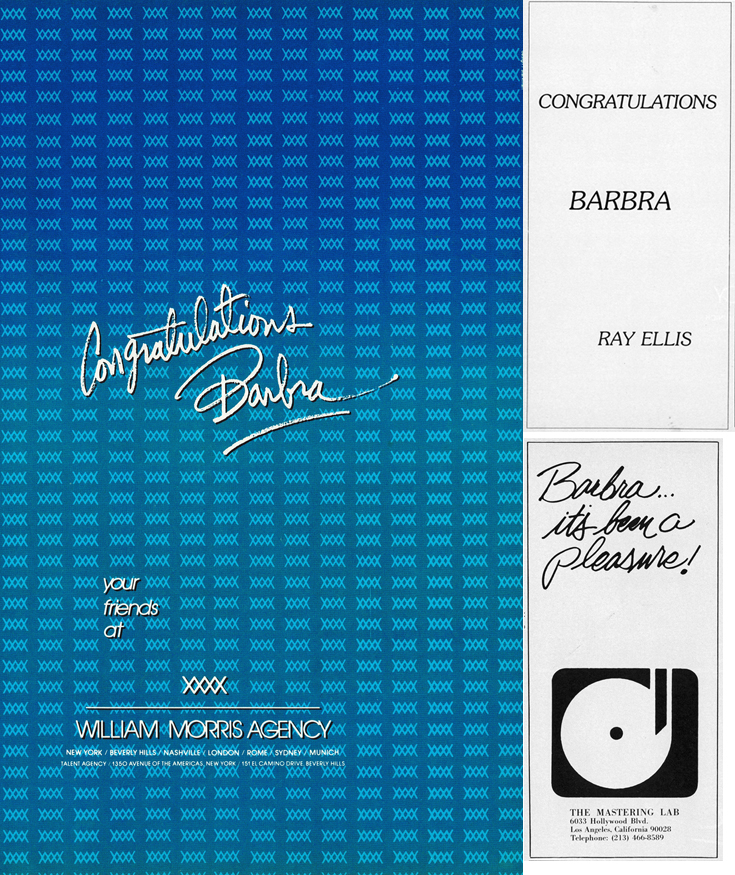
Billboard / page four
December 10, 1983
The Legend of Barbra Streisand (continued)
Page 1 | Page 2 | Page 3 | Page 4 | Page 5


'YENTL': 'THE MOST EXCITING THING WE'VE EVER DONE
Alan and Marilyn Bergman have written the lyrics to some of our most beautiful motion picture songs, including "Windmills of Your Mind, " "What Are You Doing The Rest of Your Life, " "The Way We Were" and "How Do You Keep The Music Playing. " Most recently, they have written the entire lyrical score to "Yentl.

James Spada: How did you first meet Barbra Streisand?
Marilyn Bergman: It was in 1961 or 1962. We were asked to go over to Jule Styne's apartment to talk about a new show there was interest in our getting involved in, and they also wanted us to meet "this girl" they thought would be perfect for the show. We were busy casting something else and were quite disinterested in going. "This girl? Who? What?" Jule said to never mind that and just come over.
We were there a little while and in she walked, and I realize now I must have been struck by her instantly, because I remember everything about her. I remember what she was wearing—she was all in black with pants tucked into boots with a black cossack fur hat. And I remember that she was hungry. Maggie Styne fixed her a chicken sandwich and I'll never forget these long red fingernails of hers holding the white bread of the chicken sandwich against all that black.
She ate through the whole presentation of the show. I didn't even know how much attention she was paying. She was what, 19 years old? When the writers got through telling the story, she said, "That would be terrific for . . . " and she mentioned the name of another star—who was, in fact, the person the show had originally been written for. Barbra would have had no way of knowing that.
Then she described the kind of show she would do when she starred on Broadway. Not "if," mind you, but "when." And later, when "Funny Girl" opened, Alan and I realized that she had come very close to describing "Funny Girl" that day. I remember thinking at the time, "Why doesn't this sound arrogant coming from a 19 year old?" But it didn't. It just sounded like ... fact.
MB: I believe it was that same night. We went down to the Bon Soir to hear her. I was totally unprepared. She started to sing and I remember that my eyes filled up with tears and I couldn't stop crying, I was so overwhelmed. Then we went "backstage," which was a joke because her dressing room was as big as a closet. I just said to her, "You must know how wonderful you are."
JS: What was the first song of yours she ever recorded?"
Alan Bergman: It was "That Face," part of a medley on the "Color Me Barbra" album in 1966. Then she put out a single of "What Are You Doing the Rest of Your Life" from "The Happy Ending" in 1969. She saw the manuscript on our piano, and asked us to sing it for her because she liked the title. Then she offered to sing it in the film. We told her that the director, Richard Brooks, wanted it sung by an anonymous male voice. Barbra said, "I'll sing it anonymously." We weren't sure how to tell Barbra that it would be very difficult for her to sound (A,) Male and (B) Anonymous! So we left it to Richard to dissuade her. But she did record the first single.
JS: You were, I understand, among the first people Barbra approached for advice about "Yentl."
MB: Yes. We felt that it was a wonderful story, that the metaphor of the story was extremely contemporary.
JS: Why do you think she was turned down by so many studios when she tried to get financing?
AB: A lack of imagination. They couldn't conceive of a film like this being done without it being very "ethnic." I don't think they saw the fairy-tale kind of romance, the universality the film has. And they were probably afraid to trust a firsttime director-who was a woman and an actress to boot.
JS: At first, Barbra did not see the movie as a musical.
MB: No, and we thought about it for a long time before making the suggestion to her. The reason we felt it was a wonderful story for a musical is because it is a character with a secret. Throughout the picture, after her father dies, there is nobody to whom she can talk, to whom she can reveal her essential self. And this rich inner life becomes the score.
AB: And once you arrive at this, that dictates other things, like why no one else sings in the movie. That was a decision that was hard to arrive at. Barbra was afraid that it might not be perceived properly, but it became more and more inevitable. She is the musical narrator of the piece. Nobody else is part of that inner music.
MB: It was almost the same way when she tried to create scenes in which Yentl didn't appear, so she could stay behind the camera wearing only her director's hat. But each time that was tried, we felt that the audience wouldn't know how it was privy to the moment if Yentl wasn't there. The picture is told through her perceptions, seen through her eyes.
AB: By the same token, we couldn't stay faithful to the style and have anyone else sing. We tried. Mandy Patinkin was cast, and he sings like an angel - but there was just no way to utilize his gift.
JS: How did some of the songs come about?
AB: There were four or five obligatory places for songs, and we would work up a scenario or a title for the song, and Michel Legrand would come up with five or six melodies ...
MB: —or eight or 12 ...
AB: He's very prolific. In addition to being a composer, he's a dramatist. The first day he played two melodies out of about eight-one he'd written became "Where Is It Written?" We had talked about that, but he had no idea of that phraseand yet when he came back with the melody there it wasthe key line - "Where is it written what it is I'm meant to be?'
MB: Michel writes such vocal music. We always say, there are words on the tips of his notes.
AB: In the case of "Papa, Can You Hear Me?" I know that phrase was never used until those notes were played. And the greatest thing about working on this movie was: where else in the world can you call your director and say, "Come over and sing this song for us?" Barbra would come over and we'd go upstairs and she would sing all day long. And we'd work on the song. She's got great instincts-the four of us would say, "we should do this, we should change that." We'd work late into the night. It was as if there were no outside world. We'd have our food brought up to us, never looking at the clock.
MB: It was a wonderful time, those few months up there ...
JS: When you hear Barbra singing in your living room, is it just as magical as when we hear her on our turntable?
MB: Maybe more.
AB: I think the logo for the picture, "Nothing's Impossible," is also what she believes. Whenever you tell her something's impossible, you're just firing her up. And a lot of people don't want to work as hard as she wants to. She works very, very hard.
—JAMES SPADA
[ top of page ]
